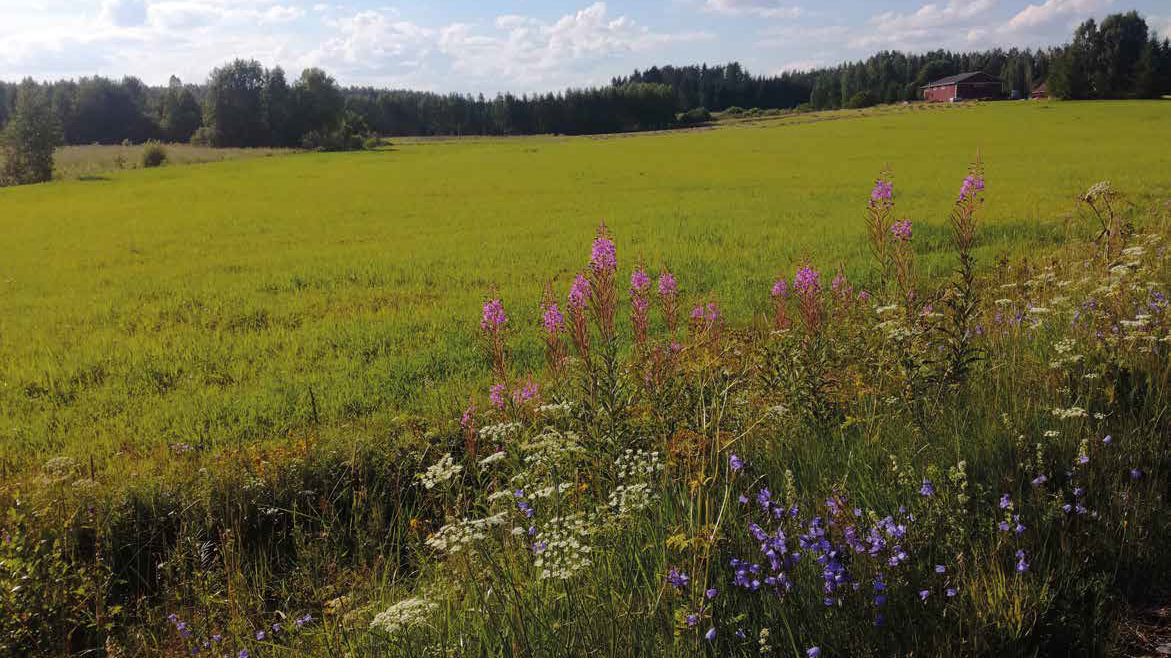The Purnujärvi cultural landscape contains ancient military history exemplified by the fiefdoms and endowed lands from the time of Swedish rule. Endowments were given in return for services and actions for the benefit of the Crown. The most notable recipients of endowments in the 1600s were Lieutenant Prusi Henrikinpoika Töperi, the Latvian Baron Reinhold von Ungern-Sternberg and the German-born Major Friedrich von Fitinghoff. No building stock has survived from the period.
The village of Purnujärvi lies in an undulating rural landscape, strips of field edged by forest descending to the Hiijärvi lake; buildings erected on the high hills command a fine view of the nearby lakes.
At the side of the Niskapietilä road, winding its way through the scenery, stands a partially moss-covered low commemorative stone bearing the text ’Purnujärven lahjoitusmaahovi [Purnujärvi endowed estate court] 1653–1905’. It marks the site of the mansion of an estate, known as the ’court’, which once stood there.
The building no longer exists, nor is there any other visible reminder of the time centuries ago. But the spirits are on the move, waiting for a sufficiently nervous traveller to tell him their tales.
Like that one there, Lieutenant Töperi, sometimes described as a Russian warlord. Who knows, perhaps he had something to do with nearby Kasakkaharju or ’Cossack Ridge’ and the skulls found there. Some people also say that he was just a local village lad, originally from Korpjärvi. His name was Prusi Henrikinpoika and the Swedish version also exists, Ambrosius Hendersson.
Now Teperi, whoever he may be, wanders restlessly bragging over his success and boasting about his property. Rakes his gnarled fingers through his thick, grey mop of hair and grimaces, showing his yellow front teeth, whenever he is especially pleased with his choice of expression.
Once more, he recounts his career, beats the memorial stone in time to his tale. How he began as a wagon boy, soon advanced to corporal, then cornet, lieutenant and finally cavalry captain. ’A hero of the Thirty Years’ War, that I am’, he croaks on and trumpets an emotional droplet from his beak remembering his faithful mount, or a few of them.
Once he gets to the description his grisly death in the battle of Gnezen, in which he commanded the Jääski Squadron of the Vyborg Cavalry Regiment, there is no stopping him. Teperi struts around on his bow legs, blows raspberries and flails his arms as if he had a sabre in one hand and the horse’s reins in the other, and finally vanishes into the mist-shrouded road with a terrible roar.

Baron Reinhold von Ungern-Sternberg is a more composed figure. He stands still in a proud and elegant pose, one leg across and slightly in front of the other, left hand on his hip and the thumb of his elevated right hand bent in a cupped position alongside the rigid fingers. He is also always impeccably dressed, with a headpiece adorned with a feather atop his white, curling hair.
The baron does not speak much, being more inclined to cast his eyes about him and at the commemorative stone, as if gauging its worth. But when he does speak, he talks of the lands endowed to him by Queen Christina in her time in return for the estates in Livonia the baron generously gave up to the Crown. Then he moves on to describe the lands of Hinkkala, Jurvala, Purnujärvi, Pirhola and Miettilä, which passed to him when the Crown paid its debts for the cavalry squadron provided by the baron for the Royal Guards.
The speech of the Latvian baron is rather an odd mixture of several languages, and his voice tends to break when he starts to describe his manor house project, planned for another location and failed, and the loss of his estates to the state. Usually at this point, the actual hero of the memorial stone, the German Major Friedrich von Fitinghoff, makes his appearance.
Fitinghoff starts off flamboyantly in guttural German, describing the mansion house of his ’court’ in Purnujärvi, although he never saw it completed. In place of around twenty farms gifted to the major by the Crown, the mansion with its ancillary buildings was not finished until the major had passed to join other spirits, after Töperi but a good while before the Latvian baron.
Pekka Vartiainen
Transl. Annira Silver
Picture in the top of the page: Anu Nuutinen
Location on map
The story and the pictures are a part of Tarinajoki book (River of Stories), made in Rural Explorer project. As part of a culture tourism project, stories arising from the body of folk narratives and history also have a function in relation to the productisation of tourism. The stories are linked to real locations.
